
CLARK MOUNTAIN, MOJAVE NATIONAL PRESERVE, SAN BERNARDINO COUNTY CA 18-21 May 2020 (42 Species – scroll down for an Annotated Bird List)
Callyn Yorke
Alden Miller, one of the pioneering Ornithologists in California, first visited Clark Mountain on May 17, 1939. Since then, this remote and stunningly scenic area has received occasional visits by adventurous biologists and sport-birders seeking to add to the general knowledge of bird distribution in California, and perhaps catch a glimpse of a rarity or two, for which this ‘coniferous island in the desert‘ has become well known
My colleague Dan Byrne and I took a few days off from our online teaching routines (COVID-19 pandemic protocols in place) to explore the natural history of Clark Mt., where neither of us had been before. And, perhaps like Alden Miller, we were rewarded by surprises, delightful and otherwise, including some rather unforgiving roads.

Navigating the unsigned back roads in this area was possible largely due to a vintage (1990) map provided by the Auto Club of Southern California (Figure 1). We found this map to include most of the landmarks and passable secondary roads and tracks, annotated with accurate mileages. Understandably, the only essential information missing was the road condition. In some sections, even our 4WD vehicle moaned and groaned as it crawled over embedded boulders, sometimes tilting steeply to straddle deep gullies and wash-outs. Make no mistake, many secondary roads around Clark Mt. are impassable with conventional autos and trucks, and in some places, nearly so with high-clearance 4WD. In this gloriously pristine wilderness, even a minor breakdown, e.g. dead battery, flat tire or broken suspension, could easily result in a hike of many miles across the desert for help; cell phone reception was spotty throughout.
Camp #1 Pachalka Spring (5/18 – 5/20)

We reached our first campsite at Pachalka Spring at 1420 hrs. on May 18. Along the way, we made several stops to walk in a dry, canyon wash on the western slope, which had a high density and diversity of cacti, beautifully displayed with many flowering annuals and shrubs, clinging to Mesozoic metamorphic cliffs and loose Quaternary volcanic rocks. Except for a few abandoned mine shafts, this area was pristine and apparently seldom disturbed by human activities.

Here we had our first glimpse of a Woodhouse’s Scrub-Jay (Aphelocoma woodhouseii), seconds before it retreated to a sparse patch of pinyon-juniper at higher elevation. Recognizable, yet relatively high-pitched scrub-jay calls, together with a dusky brown plumage, were immediately apparent. Also peculiar to this interior scrub jay species, was its comparatively shy behavior; wherever encountered in the Clark Mt. area, these birds were always a few milliseconds faster than I was with my camera.

Pachalka Spring was one of our primary destinations on this journey, especially because all previous reports by scientists and birders that could be found for this location, indicated that only cursory bird surveys had been made.


This seemed initially odd to me, since any sizable spring in the desert should be alive with interesting organisms, especially birds.

But when we encountered the steep, washed out road leading to the site, it was immediately apparent why so few naturalists come this way; the going was punishingly rough for about a mile, between the old canyon mine area and Pachalka Spring.

We pressed on and found a suitable campsite with some dilapidated buildings and concrete slabs, just a stone’s throw from the riparian patch at the spring.

It was a perfect base for exploring the area, armchair birding after a long hike, and enjoyable campfire discussions. In fact, from our camp chairs in the late afternoon on May 19, 2020, we made the first of two sightings of an adult Zone-tailed Hawk, flying over us in a southerly direction, a notable rarity in the region.
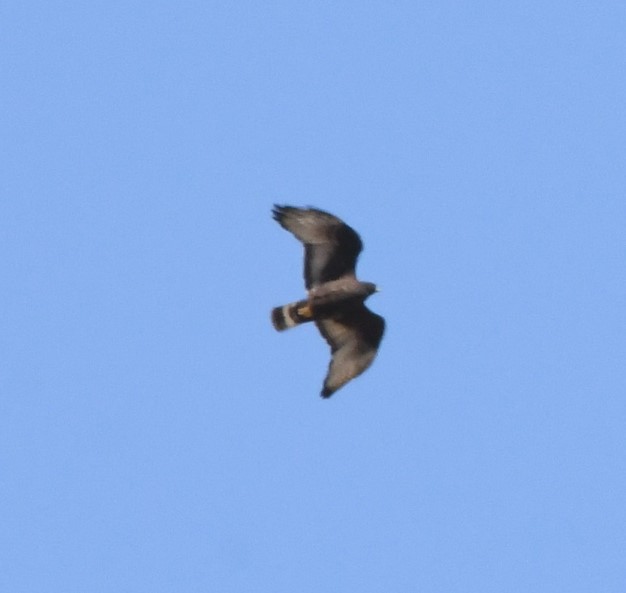
We made frequent surveys of the area on foot, but failed to locate any surface water at Pachalka Spring. It was evident from the moist soil and wetland vegetation, e.g. Yerba mansa (Anemopsis californica) beneath a shady stand of Black Willow (Salix nigra), that there was significant seasonal surface water in this location.

Watching a pair of House Finch disappearing momentarily into the tall grass within the riparian patch, suggested there was a small amount of water available to wildlife, perhaps even during the dry season.
Mid to late May, although ambient temperatures are relatively mild (40F to 73F), is a bit past the peak of spring migration in this region; thus, we hadn’t expected to find many northbound species. However, two successive afternoon and morning surveys in and around the spring, produced a diversity of migrants, including Olive-sided Flycatcher, Western Wood Pewee, Pacific-slope Flycatcher, Dusky Flycatcher, Willow Flycatcher, Cedar Waxwing, Warbling Vireo, Swainson’s Thrush, Western Tanager, Virginia’s Warbler, Wilson Warbler, Lazuli Bunting and Black-headed Grosbeak.
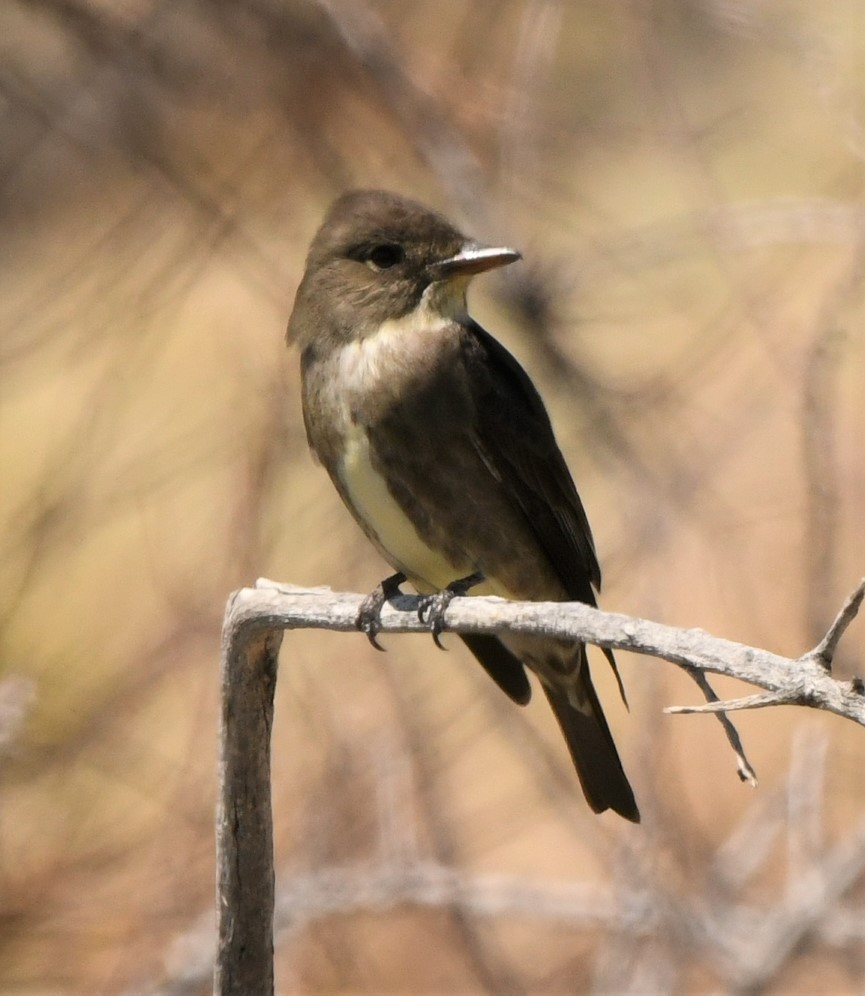
Interestingly, not all of the above mentioned species were found on both days, suggesting a rapid and differential turnover rate during migration. Given the relatively small riparian area (about 0.3 acre) at Pachalka Spring, and fairly high number of resident and transient birds occupying it at any given time during our visit, it seems likely that migrants would be hard pressed to find adequate resources supporting lengthier stays. For that reason, brief visits to Pachalka Spring by casual birders, having already expended considerable effort just to arrive, would be unlikely to find much of interest. That indeed appears to be the case, at least in the few published eBird accounts I have found for this site.

Camp # 2: North Slope of Clark Mountain (5/20 – 5/21)
We might have added a few more bird species to our trip list for Pachalka Spring, but our food and water supply was limited to about four days. Additionally, having seen the horrid road conditions thus far, we were a little unsure if our luck driving around with reckless abandon would hold out much longer. So, following a morning bird survey and a cold air weather system moving northward through the area, we set out for Camp #2, this time motoring mostly downhill until reaching some relief a few miles to the west on Kingston Rd., which was well paved.

Any ya-hoo with off-road experience probably knows that going downhill can be more treacherous than going uphill. Not only is the vehicle’s forward momentum often barely controllable on steep grades, but depth of field is reduced due to a low angle of visibility; half buried boulders appearing harmlessly shallow, when contacted by the front wheels, may suddenly throw the steering wildly to and fro. Under such conditions, even at speeds less than 5 mph, serious damage to the vehicle can readily occur. Luckily, all that we lost on the road out of Pachalka Spring was an accessory step on the passenger side, that broke off while ‘boulder hopping.’ But our luck soon ran out a few miles before we reached the turn-off to Camp #2, while on a deeply washboarded powerline access road. The relentless pounding eventually broke the rail anchors of one of the roof-top carrier boxes, resulting in the loss of the carrier box with half of our gear inside (the latter items were salvageable).

Neither of us had the ambition or stamina required for a three-hour hike from the Camp #2 to the White Fir (Abies concolor) forest that could be seen below the base of jagged limestone peaks, reaching nearly 8,000 ft. in elevation.

Instead, we prudently chose to bird the pinyon-juniper belt around the camp and up the trail to about 5,280 ft. in elevation. Aside from a slight increase our elevation compared with Camp #1 (4,650 ft.), and essentially similar geology, the shadier and topographically dissected north face of Clark Mt. supports a varied ecological assemblage, particularly of birds.

Most of the bird species added to our trip list at Camp #2, were those that required relatively mesic woodland habitats.

Evidently, continuous stands of Pinyon Pine and Utah Juniper occurring on the lower and middle north slope of Clark Mountain, provide sufficient cover and resources for a distinctive assemblage of desert, foothill-woodland and chaparral birds. Disjunct stands of White Fir (Abies concolor) at elevations above 6,000 ft. on the north slope of Clark Mt., support a small and annually variable assemblage of birds typically associated with higher elevations in the San Bernardino and San Gabriel mountains of Southern California.


Clark Mountain is an outstanding example of a remote ‘conifer island’ in the desert, a fact which initially attracted the attention of biologists such as Alden Miller and Ned K. Johnson, and subsequently activated the imaginations of scores of recreational birders seeking to add rarities to their California state lists.
We surveyed the camp and Clark Mt. trail on the afternoon and evening of May 20; then again on the morning of May 21, totaling about ten hours each of independent of observations. Birds found in this area which were new for our Clark Mt. trip list included, Anna’s Hummingbird, Hairy Woodpecker, Townsend’s Solitaire, Bushtit, Bewick’s Wren, Juniper Titmouse, Chipping Sparrow and Scott’s Oriole. A new mammal for the trip list was Desert Woodrat, which apparently had built its nest in the largely unused campground fire pit. A relatively large bat flew over our campsite after dark but was not specifically identified.
Our return trip in the late morning of May 21, produced some delightful, if not fortuitous surprises. Dan had lost his sunglasses somewhere between Camp #2 and Kingston Rd. along with three out of four rail caps on the roof rack of my vehicle. Incredibly, all of those items were recovered along the way back. And if that wasn’t enough good fortune, we had another fly over by an adult Zone-tailed Hawk (probably the same bird seen at Camp #1) and a few minutes later, an Eastern Kingbird perched on a creosote bush next to the same powerline road. Dan suggested we should keep the winning streak going and buy a lottery ticket. But we were both fatigued and ended the day sufficiently enriched by the results of our trip.
Overall, this was a productive, mini-natural history expedition into a very scenic and fascinating part of California, known officially as the Mojave National Preserve, now administered by the National Park Service. Thanks to the legislation sponsored by key politicians beginning in the 1980’s, i.e. Senator Alan Cranston, President George W. Bush, Senators Barbara Boxer and Dianne Feinstein, the Mojave National Preserve is largely pristine and should stay that way, provided NPS continues to supervise and control public and private usage. Indeed, the relatively difficult access and lack of facilities in the Clark Mt. area, has prevented widespread abuse and destruction of natural resources that is distressingly familiar in areas adjacent to Southern California towns and cities. There is a vanishingly small number of places like the Mojave National Preserve remaining in California, where one can enjoy the beauty and quiet solitude of an unspoiled desert wilderness.
In the words of Edward Abbey,
“Wilderness is not a luxury but a necessity of the human spirit, and as vital to our lives as water and good bread.”

Annotated List of Birds (42 Species) Found in the Clark Mt. Area (5/18 – 5/21/2020) compiled by Callyn Yorke
Key: Numbers indicate the maximum number of individuals observed when there was more than one survey in a particular area; Locations: KR = Kingston Rd., WCM = west and southwest slope and canyons of Clark Mt.; PS = Pachalka Spring and vicinity; PLR = powerline access road; NCR = north slope roads of Clark Mt.; C2 = Camp #2 and lower trail on the north slope of Clark Mt.. DB = Dan Byrne.
- Mourning Dove Zenaida macroura 2 in and around the riparian trees, PS
- Lesser Nighthawk Chordeiles acutipennis 2 one flying low over each camp at dusk, PS, C2
- Anna’s Hummingbird Calypte anna 1 (female) foraging on inflorescences of Bladder Sage (Salazaria mexicana), C2 (photo)
- Costa’s Hummingbird Calypte costae 2 (male, female) hovering over and alighting frequently on upper branches of desert almond trees; buzzing red colored objects at camp, including DB’s red hat band, PS (photo)
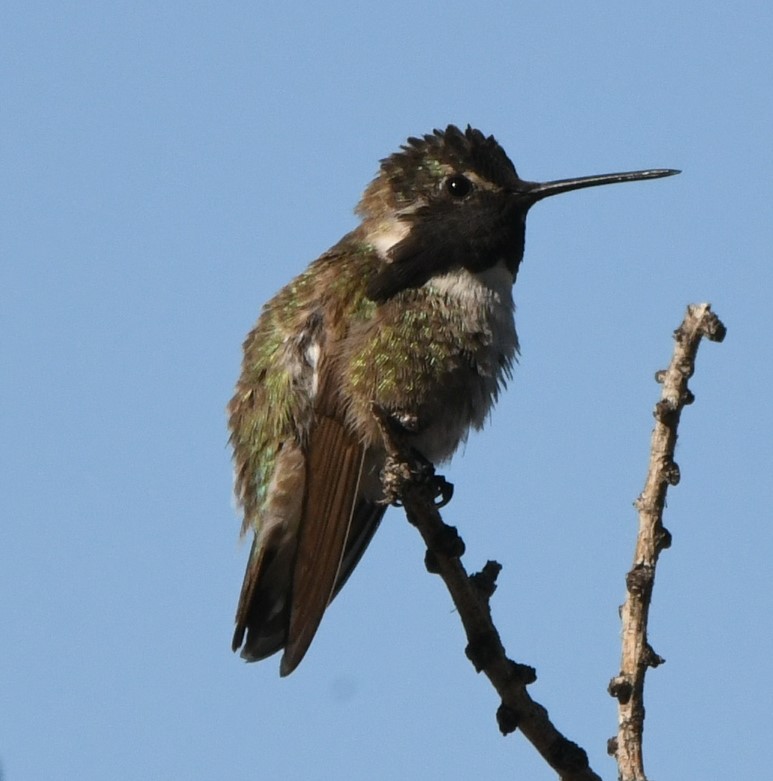
- Zone-tailed Hawk Buteo albonotatus 1 adult observed and photographed from camp at 1413 hrs. on May 19, circling and then flying at about 150 ft. a.g.l. in a southerly direction, PS (photos); another adult (probably the same bird) seen flying south over high voltage power lines (see Figure 1), both sightings provided visual ID by black and white banding on tail, PLR.
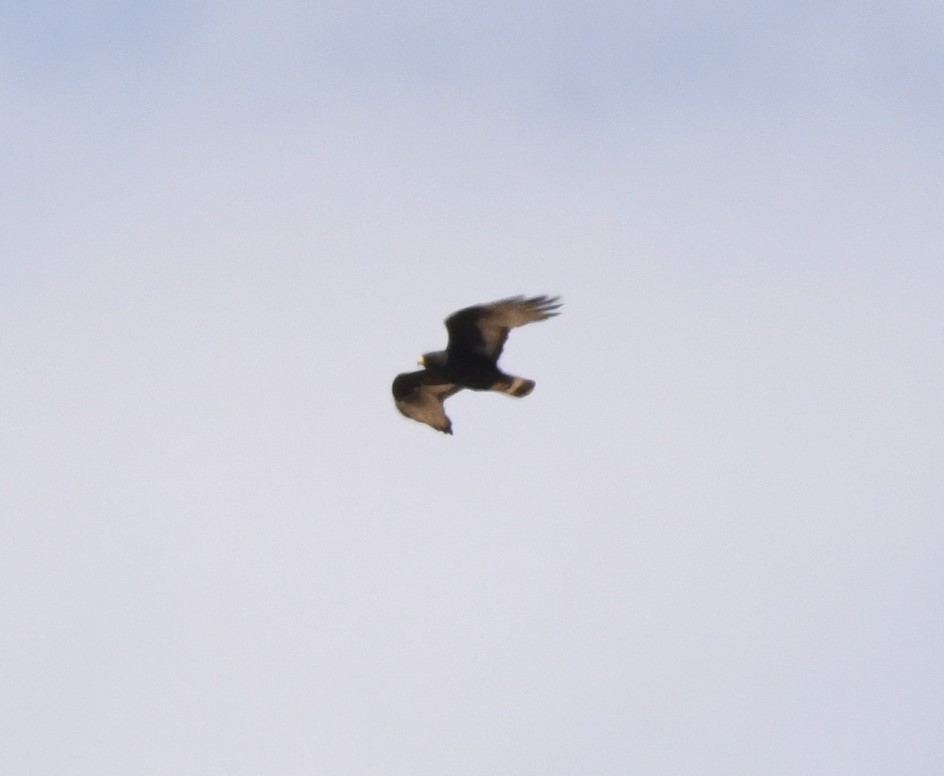
- Golden Eagle Aquila chrysaetos 1 imm (light patches visible in wings) flying 100 ft. a.g.l. toward camp in a northerly direction, PS (photo).

- Ladder-backed Woodpecker Dryobates scalaris 2 (male, female) vocal, active on outer limbs of leafless willows; many woodpecker holes (fresh and older) in dead and living willows, PS
- Hairy Woodpecker Dryobates villosus 1 (female) alighted briefly in subcanopy of large pinyon pine, C2
- Olive-sided Flycatcher Contopus cooperi 1 sallying from a snag at the edge of the riparian patch, (5/18/20 only) PS (photos)
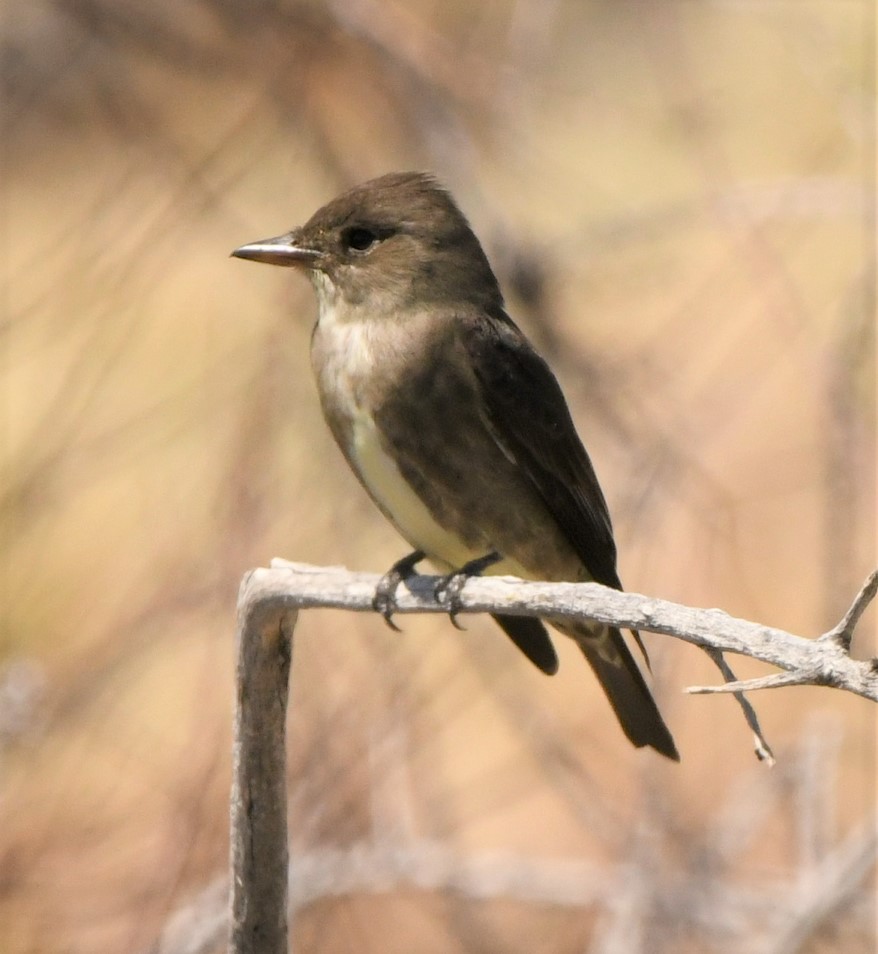
- Western Wood Pewee Contopus sordidulus 1 sallying from low limbs inside riparian patches, PS (photo)
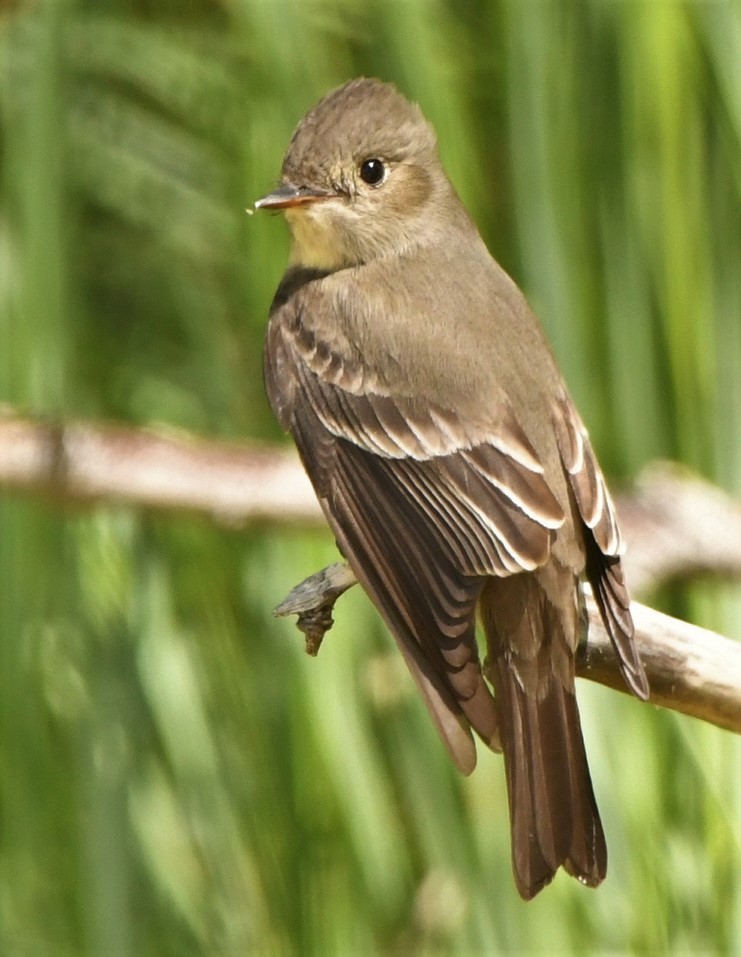
- Willow Flycatcher Empidonax traillii 1 snatch-gleaning insects off grasses and low foliage; flycatching inside riparian patch (5/19 only), PS.
- Dusky Flycatcher Empidonax oberholseri 1 active on outer sections in lower to middle level of willows inside riparian patch (5/19 only), PS.
- Pacific-slope Flycatcher Empidonax difficilis 1 active inside and outside tree subcanopy to near ground level, PS (photo)
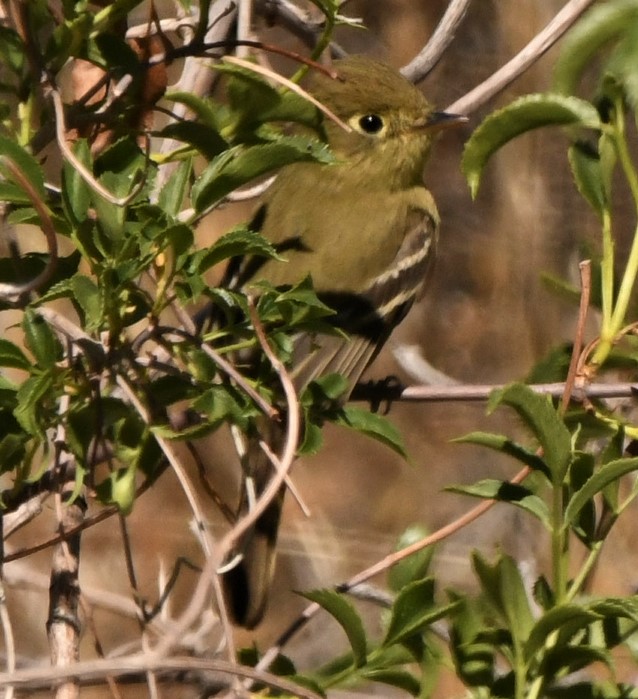
- Ash-throated Flycatcher Myiarchus cinerascens 6 pairs flushed from roadside creosote bushes and other tall shrubs throughout lower slope areas, especially PLR.
- Eastern Kingbird Tyrannus tyrannus 1 initially seen at about 1100 hrs. on 5/21/20, perched atop a creosote bush about 15 yards ahead of our vehicle, making short, vertical sallies, on the north side of PLR, then, as we exited the vehicle to confirm the ID, the bird flew to at least three other perches 20 -50 yards away, before disappearing to the south (see Figure 1). ID: an evenly proportioned kingbird, with an unmistakable profile, showing uniform blackish to slate gray above and white below, extending to chin, PLR.
- Western Kingbird Tyrannus verticalis 1 flushed from a series of roadside creosote bushes, near the intersection of Kingston Rd, PLR.
- Loggerhead Shrike Lanius ludovicianus 1 flying low over creosote bushes near roadside gully, PLR.
- Warbling Vireo Vireo gilvus 1 active in the canopy of willows, (5/19 only) PS
- Woodhouse’s Scrub-Jay Aphelocoma woodhouseii 2 vocal, loosely gregarious as pairs in pinyon-juniper areas and adjacent habitat, shy and retiring, WCM, PS, C2 (photos)
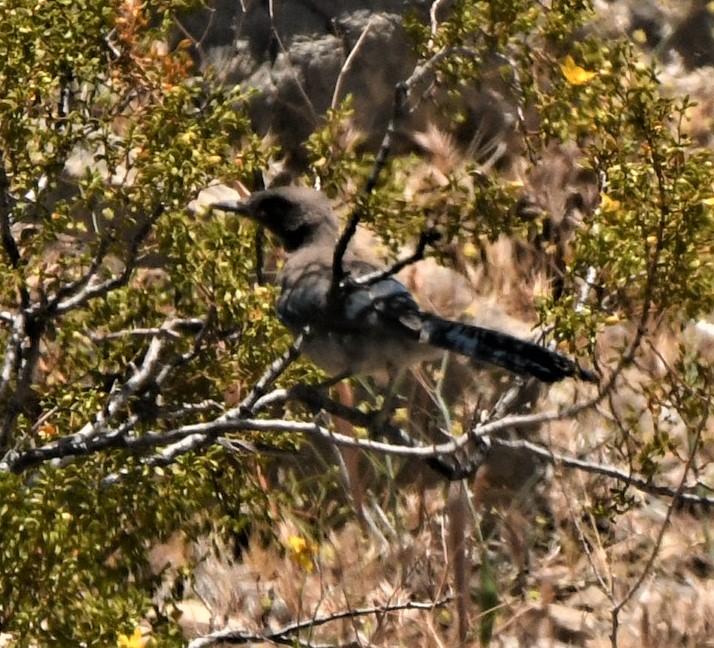
- Northern Raven Corvus corax 1 flying south at about 100 ft. a.g.l., KR
- Violet-green Swallow Tachycineta thalassina 2 individuals and pairs flying low, back and forth over open desert and edge of riparian patch in the afternoons, PS
- Juniper Titmouse Baeolophus ridgwayi 2 vocal and active in middle of pinyon pines and junipers, C2
- Verdin Auriparus flaviceps 2 vocal, active in mesquite and other large shrubs, WCM, PS
- Bushtit Psaltriparus minimus 1 (DB) in pinyon-juniper woodland on lower trail, C2
- Rock Wren Salpinctes obsoletus 1 vocal, on top of rocky road cut, PLR.
- Bewick’s Wren Thryomanes bewickii 1 vocal (repeated song) atop a pinyon pine, C2
- Blue-gray Gnatcatcher Polioptila caerulea 3 individuals and pairs, usually silent, foraging in mesquite, creosote bush, saltbush and pinyon pines, WCM, PS, C2
- Townsend’s Solitaire Myadestes townsendi 1 flying low, downslope over pinyon-juniper woodland on lower trail, C2
- Swainson’s Thrush Catharus ustulatus 1 staying low in shade of riparian patch, (5/19 only), PS
- Crissal Thrasher Toxostoma crissale 1 flushed from tall shrubs in gully across from abandoned homestead on upper road, PS; flushed from roadside mesquite, NCR
- Cedar Waxwing Bombycilla cedrorum 14 a cohesive flock repeatedly circling the riparian patch and alighting in a leafless willow canopy, (absent on 5/20) PS (photo)

- Phainopepla Phainopepla nitens 2 (male, female), vocal, individuals and pairs in adjacent desert scrub with high, conspicuous perches, PS, NCR
- House Finch Haemorhous mexicanus 4 (male, female) vocal, gregarious, often paired PS, NCR
- Pine Siskin Spinus pinus 3 alighted briefly atop leafless willow, PS.
- Virginia’s Warbler Leiothlypis virginiae 1 active at outer edge and in understory and lower middle of willows, (5/18 only), PS
- Wilson’s Warbler Cardellina pusilla 2 (male, female) active at all height levels in willows and adjacent shrubs, PS
- Chipping Sparrow Spizella passerina 2 unseen, vocal (repeated song), at edge of pinyon-juniper woodland and desert scrub, C2
- Black-throated Sparrow Amphispiza bilineata 6 vocal, individuals and pairs, ubiquitous in desert scrub in a wide range of elevations.
- Western Tanager Piranga ludoviciana 3 (male, female, adult, immature) vocal calls in riparian and singing in pinyon-juniper, PS, C2 (photo)

- Black-headed Grosbeak Pheuticus melanocephalus 1 (male) investigating a concealed water source with HOFI in riparian patch, PS
- Lazuli Bunting Passerina amoena 3 (female) gregarious, perched on leafless outer limb of a willow, PS
- (Great-tailed Grackle Quiscalus mexicanus 1 male, vocal and active in palms and shrubs in a Baker gas station- mini mart)
- Scott’s Oriole Icterus parisorum 1 male, singing continuously atop a pinyon pine, next to camp and on lower trail, C2; 1 flying, NCR.